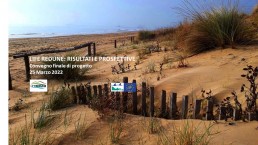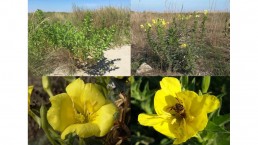DUNES AND TOURISM: GUIDELINES FOR SUSTAINABLE MANAGEMENT
The dunes have the important function of naturally defending the hinterland from storm surges. But how to keep the dune systems intact on the beaches invaded by tourists? Experts and scholars who have worked in the field along the Venetian coast in the last four years have developed guidelines for sustainable tourist use and the correct management and long-term conservation of dune ecosystems.
They will be presented during the final event of the LIFE REDUNE project, scheduled for Friday 25 March from 9.30 in the Mainardi Auditorium of the Scientific Campus of the Ca 'Foscari University of Venice (via Torino, 155). The event is open to the public and will be an opportunity to learn about and deepen the ecological value, in terms of biodiversity and ecosystem services, of Mediterranean coastal systems. The conference will be held simultaneously in person and online.
The LIFE REDUNE project "Restoration of dune habitats in Natura 2000 sites of the Veneto coast", co-financed by the European Union and led by researchers from the Department of Environmental Sciences, Informatics and Statistics of the Ca 'Foscari University of Venice, with the partnership of the Veneto Region, Veneto Agriculture, EPC srl and SELC soc. coop., has been active in the restoration and conservation of the habitats typical of coastal systems in the areas of Bosco Nordio, Peninsula of Cavallino, Laguna del Mort and Pinete di Eraclea and Laguna di Caorle and Foce del Tagliamento.
The conference aims to promote the exchange of knowledge and good practices for the conservation and sustainable management of sandy coastal systems. Classified as globally threatened habitats, these ecosystems are an important reservoir of biodiversity and crucial elements of resilience of coastal territories, contributing to the control of coastal erosion and the mitigation of extreme climatic events
Attendants:
Gabriella Buffa , Ca 'Foscari University of Venice - Scientific Coordinator of LIFE REDUNE
Salvatore Orlando , Director of the Department of Environmental Sciences, Computer Science and Statistics of the Ca 'Foscari University of Venice
Cristiano Corazzari , Councilor for Territory, Culture, Security, Migration flows, Hunting and fishing, Veneto Region
Federico Vianello , Director of the Operational Unit for Plumbing, Forestry and Naturalistic Areas, Veneto Agriculture
Speakers:
Annelore Bezzi and Giorgio Fontolan , University of Trieste, The beach and dune system: processes and functions
Alberto Barausse , University of Padua, The conservation of coastal biodiversity in a context of climate change: cost or opportunity for sustainable development? The experience of the Interreg Italy-Slovenia "ECO SMART" project
Alessandro Berton , President of Unionmare Confturismo Veneto, Environmental sustainability as an economic driver for seaside tourism
Giovanni Mattias , Councilor for the Environment Municipality of Pomezia, Managing a man-made dune: the example of the municipality of Pomezia
Marco Abordi , Technical-scientific coordinator of the process "Wet Area Contract of the Caorle and Bibione Lagoon System", The experience of the "Wet Area Contract of the System of the Lagoon of Caorle and Bibione ”in the involvement of all local actors aimed at shared actions for the protection and enhancement of coastal and lagoon ecosystem values.
Corrado Battisti , Metropolitan City of Rome, Citizen Management aimed at protecting disturbed dune ecosystems: case study at 'Torre Flavia' SPA
Giosuè Cuccurullo , Councilor of the Municipality of San Michele al Tagliamento - President of the Foce del Tagliamento Nature Reserve Committee, Here everything is dune
Francesco Cancellieri, Vincenzo Piccione , Assocea Messina APS; President of the Committee of Promoters of the Charter of the Guardian Municipalities of the Mediterranean Macchia, The path of the Charter of the Guardian Municipalities of the Mediterranean Macchia and future perspectives
Federica Piccolo , EPC srl - Communication and Project Manager of LIFE REDUNE, Inform and listen to stakeholders
Edy Fantinato , Ca 'Foscari University of Venice, The containment of tourist flows and anthropogenic pressure
Jacopo Richard , Veneto Agriculture, Methods of cleaning the beach and management of beached material
Francesco Scarton and Marco Baldin , SELC coop. Low-impact naturalistic engineering
Roberto Fiorentin , Veneto Agriculture, Restoring dune habitats
Mauro Giovanni Viti, Veneto Region, Regional adoption of the Guidelines for the sustainable management of beaches
Handcrafting, suitable tools
The yellow-flowered Oenothera stucchii Soldano is an alien species that has colonized the dune systems to the detriment of the native species. The particular germination niche with high affinity for light, high seed production and rapid growth guarantee greater competitiveness in disturbed contexts and a strong tendency to invasiveness. In the areas of intervention of Life Redune, the habitat of choice of O. stucchii is represented by 2130 *.
The Life Redune project involved annual eradication of O. stucchii for three years and monitoring of the populations of O. stucchii to evaluate the effectiveness of the containment action in reducing their density in the intervention areas.
The monitoring activity envisaged the delimitation of four test areas - two at the Cavallino Treporti Punta Sabbioni site and two at Punta Capalonga - subjected to different containment practices: eradication by hand or by brush cutter. Within each test area, 3 permanent plots of 1m × 1m were geo-referenced, in each of which the number of O. stucchii individuals was recorded in July 2019 (before the implementation of the interventions), in July 2020 (at one year from the first cycle of interventions) and in July 2021 (one year after the second cycle of interventions).
From the monitoring it emerged that the number of individuals of O. stucchii has generally decreased, regardless of the site examined and the type of containment action implemented . In particular, compared to the conditions prior to the start of the interventions, in 2021 there was an average reduction in the number of individuals equal to 28.6% in areas subjected to manual eradication and 58.5% in areas subjected to intervention by brush cutter.
The greater reduction in the number of individuals of O. stucchii following the intervention with a brush cutter can be traced back to the less disturbance caused to the habitat by this type of action compared to manual eradication, which even if carried out correctly, still involves movement of the sand, due both to the extraction of the root system and to the foot traffic by the operator.
O. stucchii tends to form particularly abundant populations precisely in conditions of high anthropic disturbance, especially in the form of trampling. Trampling, in fact, determines a lower resistance of the indigenous communities to invasion, and contributes to the resuspension of the seeds of O. stucchii on the surface of the sand, favoring their germination.




